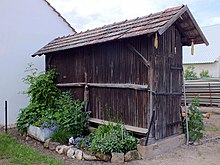Tschardake
A Tschardake (also Mais Darre ) is a device for drying and storing corn on the cob .
It is like a narrow house. It is built from wooden slats that are inserted vertically into a frame with spaces in between. Tschardaks are provided with a tiled roof.
Tschardaks were common in Seewinkel ( Burgenland ), in eastern Lower Austria and in southern Styria. After the maize harvest, they were filled with the corn cobs to be dried, from which the kernels were then peeled off for feeding to the livestock . When the Tschardake was empty, firewood came in for the winter. In the summer they used the children to play and built their “apartment” in it. In the meantime, however, they also had to vacate them to dry herbs.
Due to the industrial cultivation of maize with fossil-fueled maize drying systems, the change in heating technology (broken corn cobs can be burned piece by piece) and the changed interests of the children, the chardaks are no longer needed. They threatened to be forgotten. The municipality of Halbturn , in which there are still numerous Tschardaks, has set itself the goal of preserving them as cultural assets. The street where most of the people are is now called Tschardakenstraße, and every autumn the community celebrates the Tschardakenfest. A stylized Tschardake forms the T in the logo of the place.
Etymologically , the term probably comes from the Tschartaks (from Persian), wooden border watchtowers from the time of the Austro-Turkish military border, which were sometimes also referred to as Tschardaks. It was probably not applied to the wooden corn storage until the 19th century.
Tschardake in Podersdorf
Web links
Individual evidence
- ↑ Tschdakenfest
- ^ Meyers Großes Konversations-Lexikon 1905, page 765
- ↑ Heimatlexikon






